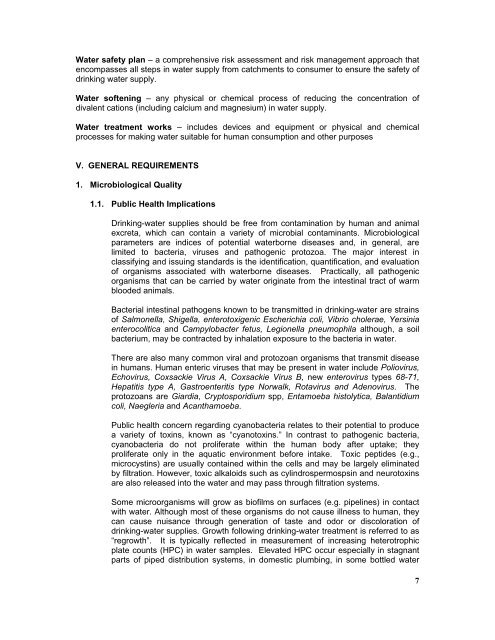Philippine National Standards for Drinking Water - LWUA
Philippine National Standards for Drinking Water - LWUA
Philippine National Standards for Drinking Water - LWUA
You also want an ePaper? Increase the reach of your titles
YUMPU automatically turns print PDFs into web optimized ePapers that Google loves.
<strong>Water</strong> safety plan – a comprehensive risk assessment and risk management approach that<br />
encompasses all steps in water supply from catchments to consumer to ensure the safety of<br />
drinking water supply.<br />
<strong>Water</strong> softening – any physical or chemical process of reducing the concentration of<br />
divalent cations (including calcium and magnesium) in water supply.<br />
<strong>Water</strong> treatment works – includes devices and equipment or physical and chemical<br />
processes <strong>for</strong> making water suitable <strong>for</strong> human consumption and other purposes<br />
V. GENERAL REQUIREMENTS<br />
1. Microbiological Quality<br />
1.1. Public Health Implications<br />
<strong>Drinking</strong>-water supplies should be free from contamination by human and animal<br />
excreta, which can contain a variety of microbial contaminants. Microbiological<br />
parameters are indices of potential waterborne diseases and, in general, are<br />
limited to bacteria, viruses and pathogenic protozoa. The major interest in<br />
classifying and issuing standards is the identification, quantification, and evaluation<br />
of organisms associated with waterborne diseases. Practically, all pathogenic<br />
organisms that can be carried by water originate from the intestinal tract of warm<br />
blooded animals.<br />
Bacterial intestinal pathogens known to be transmitted in drinking-water are strains<br />
of Salmonella, Shigella, enterotoxigenic Escherichia coli, Vibrio cholerae, Yersinia<br />
enterocolitica and Campylobacter fetus, Legionella pneumophila although, a soil<br />
bacterium, may be contracted by inhalation exposure to the bacteria in water.<br />
There are also many common viral and protozoan organisms that transmit disease<br />
in humans. Human enteric viruses that may be present in water include Poliovirus,<br />
Echovirus, Coxsackie Virus A, Coxsackie Virus B, new enterovirus types 68-71,<br />
Hepatitis type A, Gastroenteritis type Norwalk, Rotavirus and Adenovirus. The<br />
protozoans are Giardia, Cryptosporidium spp, Entamoeba histolytica, Balantidium<br />
coli, Naegleria and Acanthamoeba.<br />
Public health concern regarding cyanobacteria relates to their potential to produce<br />
a variety of toxins, known as “cyanotoxins.” In contrast to pathogenic bacteria,<br />
cyanobacteria do not proliferate within the human body after uptake; they<br />
proliferate only in the aquatic environment be<strong>for</strong>e intake. Toxic peptides (e.g.,<br />
microcystins) are usually contained within the cells and may be largely eliminated<br />
by filtration. However, toxic alkaloids such as cylindrospermospsin and neurotoxins<br />
are also released into the water and may pass through filtration systems.<br />
Some microorganisms will grow as biofilms on surfaces (e.g. pipelines) in contact<br />
with water. Although most of these organisms do not cause illness to human, they<br />
can cause nuisance through generation of taste and odor or discoloration of<br />
drinking-water supplies. Growth following drinking-water treatment is referred to as<br />
“regrowth”. It is typically reflected in measurement of increasing heterotrophic<br />
plate counts (HPC) in water samples. Elevated HPC occur especially in stagnant<br />
parts of piped distribution systems, in domestic plumbing, in some bottled water<br />
7







